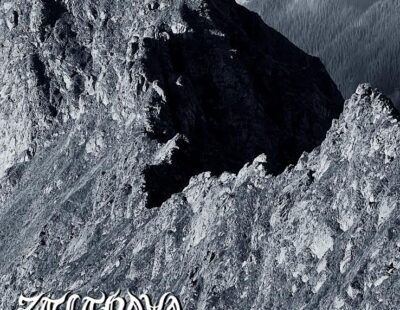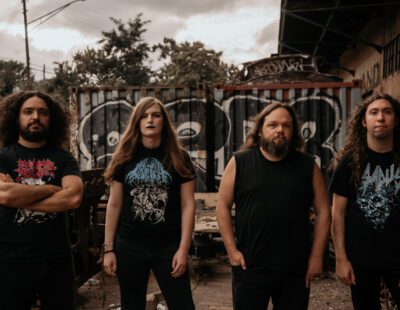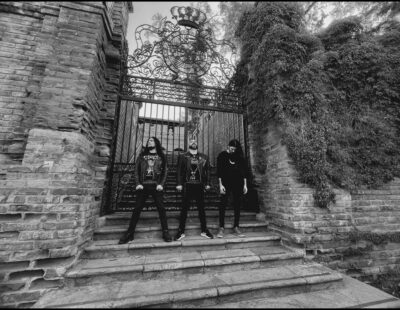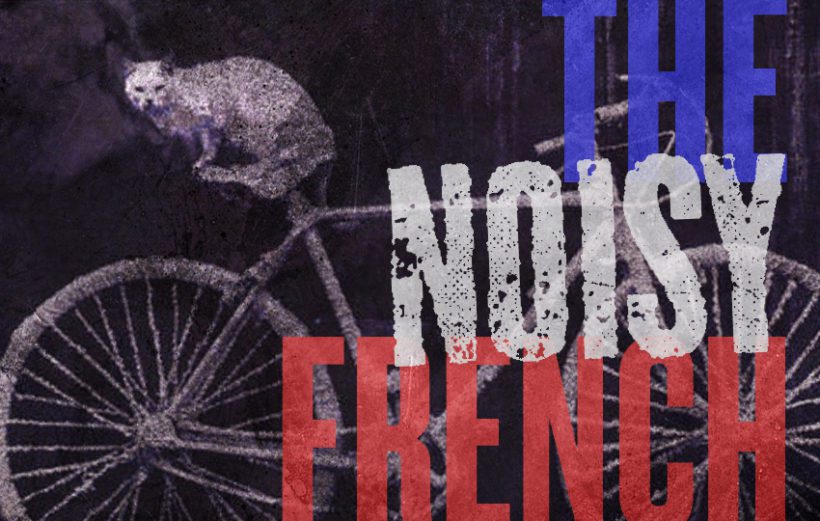
So, back in 2015, I wrote what we at Decibel like to call a ‘trendpiece’ exploring the popularity of noise rock in France. For whatever reason, after it was submitted for publication, 2,800 words of why the French find comfort in the noisy and abrasive side of the musical spectrum disappeared into cyberspace and was subsequently forgotten by EIC Mudrian and even the joker who wrote it. “Must have been a good one,” I can hear the crowing from the peanut gallery. Well, you aren’t getting off entirely scot-free as recently, I found the original piece buried in the depths of my computer’s documents folder and came up with the bright idea of finally shining the light of day on it…four years later.
To be honest, I haven’t maintained the same cross-haired focus on the French noise rock scene as of late as I was in 2015. However, time stops for no one as since this was originally filed Sofy Major has released two absolutely amazing albums, Waste in 2015 and Total Dump, which is thus far is my favorite album of this year. Throatruiner Records has maintained a steady release schedule that has included Imperial Triumphant, Comity, Vermin Womb, Pyrrhon and Great Falls. Pandemonium Records hasn’t been nearly as active, but still releases the occasional recording when the feeling strikes. KEN mode has released two albums and gone from full-time touring band to not-so-full-time touring band and The Great Sabatini has issued a pair of splits, a full-length and just finished performing in front of the biggest crowd of their career at Heavy Montréal a couple weekends ago.
So, here’s hoping you enjoy, are entertained and learn something from this “piece from the past.”
THE NOISY FRENCH
“The vibe is definitely more receptive and appreciative. There are always more people at our French shows when compared to the rest of Europe, people tend to know our back catalog and the hospitality tends to be the best we get on tour. I’m not quite sure why noisy music plays the heart strings of the French sensibility, but I enjoy the fact that it does!”
To most of us on the left side of nature’s second largest drink, the French sensibility often gets confused for, or overshadowed by, the French stereotype. We’re sure you’ve heard ‘em all before: wine-swilling, frog-leg-and-horse-meat-munching, arrogant bastards who live off the public purse, bathe irregularly and exhibit remarkable cowardice in times of conflict (one of the greatest WWII-related zingers ever devised reads Q: Why are the streets of Paris tree-lined? A: So German soldiers can march in the shade). As hilarious as they may be, stereotypes are in fact rooted in misinformed exaggeration and easy to latch onto because of the minimal effort required to believe something you heard on the playground instead of actively investigating the complex nuance of sensibility.
Take the time to talk to North Americans in touring bands who have spent appreciable amounts of time amongst our Gallic friends, like the speaker of the opening quote above, Jesse Matthewson of Winnipeg’s KEN mode, and you’ll hear reports about how warmly the French embrace those on the noisier and abrasive side of the musical spectrum. From caring treatment by diligent promoters and indulgent tour-stop catering to rabid responses of appreciative crowds, noise rock bands have had their radars tuned to the fact that in France, their sonic brew seems to go over best. Feel free to add ‘noise-rock loving’ to the list of cut-and-dried French stereotypes.
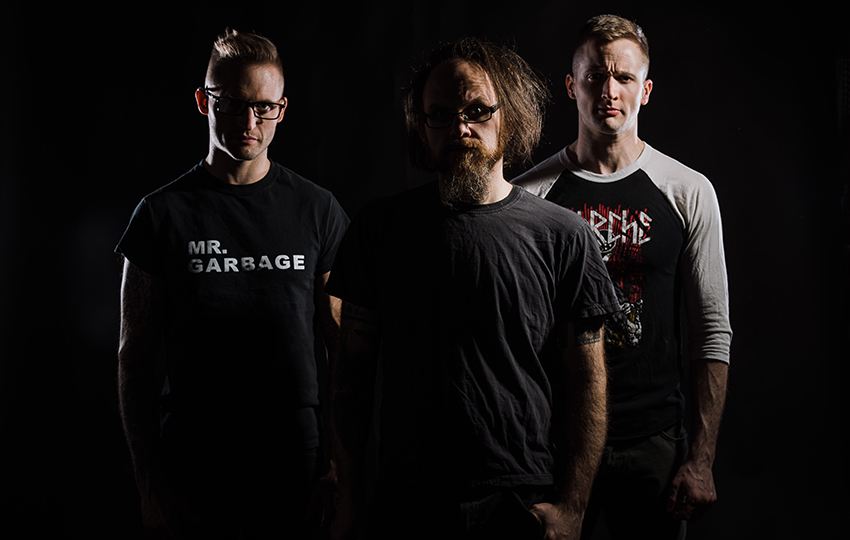
“France, in terms of turnout, is maybe a little more akin to our Canadian shows,” continues Matthewson. “I think the primary difference is that they seem to be ‘early adopters’ on the consumer index, at least when it comes to angst-y, artistic, noisy music. We noticed from the first time we toured Europe that our French shows were better; and this was back in 2008 when there literally may have been 100 people who cared about our band worldwide. I remember having conversations with people at our first show in Paris about how they thought they’d never get a chance to see us and merchandise sales were more than we’d ever experienced outside of our own hometown.”
“The gigs we did in France were great!” parrots Sean Sabatini of Montréal noise-niks, the Great Sabatini who, despite only having one European tour under their belts, also noticed a difference whilst in France. “There will be pockets of places that might appreciate what we do, but the French seem more open to music that rubs against the grain. They value it, and the musicians. We can’t expect to be fed – including alcohol – sheltered, or even paid in North America at our level, but we were well taken care of in France.”
While in the grand scheme of things, noise rock bands like KEN mode, the Great Sabatini, as well as their contemporaries and forefathers, may exist as a chip in music’s windscreen – i.e. a damaging crack always threatening to become bigger and more destructive – they have found captive audiences in France. This falls in line with the nation’s long history of welcoming artistic outliers. Back in the early and mid 1900s, the bleu-blanc-et-rouge embraced American jazz artists like Jim Europe, Miles Davis and Kenny Clarke more so than audiences at home. Previous to that, the nation provided creative inspiration and outlets for visiting artists like Picasso, van Gogh and Chagall. From the Renaissance period, baroque architecture, the Louvre and the Cannes Film Festival to the Eiffel Tower, Tour de France, Blut Aus Nord and the writings of Sarte, de Sade, Foucault and Camus, France has had a historical fascination with boundary pushing – sometimes to the point of institutionalization, incarceration and revolution. Hell, even Trust, the band that wrote “Antisocial,” stood out in ‘70s and ‘80s hard rock/metal circles for their anarchist lyrics and rampant socio-political themes. Deep thinking on edgy subject matter and consistently poking at perimeters has been a longstanding mainstay of French artistic culture. From the outside looking in…
“It makes sense they would have an affinity for noise rock as it’s a weird corner of rock and roll,” ponders Sean Sabatini. “Magma are from France, are they not? Historically, they accepted the old jazz guys with open arms and appreciate underdog weirdos, like Jerry Lewis.”
…though maybe not so much from the inside looking out.
“Yeah that’s something the KEN mode guys and others have told me, but I never believed it!” laughs Matthias Jungbluth, Chief Everything Officer of Laval-based Throatruiner Records when told of the positive light his native land is held. “Most North American bands’ European tours are comprised of 10 German shows and, if we’re lucky, one show in Paris. France is an expensive country to tour, smaller venues are disappearing and people are not always easy to draw to shows. The picture may be different for noise rock affiliated bands who can count on this core of thirty-somethings who have remained active over the years.”
L’HISTOIRE COMPACTE PAS DE LIMITES
“I guess you’re familiar with the cliché that French people are arrogant? Maybe there’s some truth to this?” laughs Mathieu Moulin. He runs Solar Flare Records, is a member of Clermont-Ferrand-based noise makers, Sofy Major and is attempting to explain the nation’s rich culture surrounding noise rock, specifically, and boundary-pushing art in general. “Actually, I think that, contrary to some other countries, we give no limit to creativity. Back in the ‘90s some talented, underground bands managed to make a living playing music, but it didn’t last, and you absolutely have no chance to earn money playing this kind of music in 2015. So, the question is: ‘If we can’t make a living off our art, why impose creative limits?’”

And while both Solar Flare and Throatruiner are nurturing healthy handfuls of the present wave of noisy rock/metal, there is an extensive past to consider. Bands like Magma, Etron Fou Leloublan and Diabologum are a trio of sonic freaks that make the most appropriate historical connections to today’s irreverent extremity because, even if they had all faded into obscurity, they were bands that would have kept playing to four walls and empty cases of beer – sorry, wine… gotta keep stereotypes alive! – in order to express themselves. Encapsulating the history of weird and noisy French music is a challenge we don’t have enough time and space to tackle, but these three outfits are significant contributors and we can hear you asking “Who, who and who?”
Of all the names that emerged during our exploration French rock’s left-field lineage, Magma was the most prominent. They were a Parisian prog band founded in 1969 by classically trained drummer Christian Vander, who claimed to be inspired by a disturbing vision of humanity’s future. Their first album relates the entirely fictional – but possibly true in Vander’s mind – story of people fleeing a doomed Earth to settle on the planet of Kobaïa. Over the course of eleven studio albums and as many live records, Vander created cinematic concepts and stories and even developed his own language, Kobaïan, in which he sang. A spin-off of Magma was the musical phenomenon of ‘Zeuhl’ – “celestial” in Kobaïan – which combined prog, French jazz/fusion and symphonic rock and featured bands like Weidorje and Eskaton. Etron Fou Leloublan, which translates to “Crazy Shit, the White Wolf,” was an avant-garde collective founded in 1973 by actor and saxophonist Chris Chanet. By 1985, EFL recorded five albums that blended punk, jazz, French folk, comedic satire, the avant-garde and were one of the original participants in the Rock in Opposition Festival, which from 1978 to the present, has brought together bands with sounds and stances counter to the mainstream.
During the mid-’90s Diabologum from Toulouse issued three albums that mixed noisy rock, high-brow pop and experimental collages. Inspired by art movements like Dadaism and Situationism as much as alt-rock like Sonic Youth and Codeine, they were oft-heralded as one of the more unique French rock outfits. On #3, their final album from 1996, they replaced linear song structures with spoken word, howling and samples and became very influential on the national rock scene in the process.
Over time, the industrialized thud and dystopian sexuality of Treponem Pal, the Frank Herbert-and-Zappa inspired technical precision of Dün and slinky free-form thunder of Shub-Niggurath ushered darkness and quirkiness towards the present where more traditional and avant-garde noise rock has flourished with the likes of Sugartown Cabaret, Aussitôt Mort/Mort Mort Mort, Pneu, Papier Tigre, Deathengine, Birds in Row and Pord.
“I’ll have to admit I’m pretty ignorant of all music created before the invention of blast-beat,” jokes Throatruiner’s Jungbluth when asked to elaborate on France’s peculiar musical history, to which his label has contributed with releases by abrasive acts like Cortez, Daggers and Comity. “Our musical scene is too diverse to be summed up easily, and the roots often extend far beyond our boundaries. However, different waves of pre-2000 screamo bands such as Jasemine, Fingerprint and Ananda had a huge impact. Then, later came Amanda Woodward and Mihai Edrisch. The noise/indie scene was quite important in the ’90s with Kill the Thrill, Condense, Bästard, Portobello Bones and Hint as well as acts that brought something new to black metal like Deathspell Omega, Blut Aus Nord and Aluk Todolo. I have to mention Kickback’s 2008 album, No Surrender which was a game-changer. They weren’t the first band to bring other influences like noise or black metal to hardcore, but it hadn’t ever been done before so naturally and painfully.”
GUERRES DE LA CULTURE
Still, even unfettered artistic freedom needs something to push against. In the same way you can’t have the “evil” of King Diamond without the contrasting “good” of Believer, while French audiences may be more accepting of sonic discord, it’s not like school kids are being taught about the Melvins, Cows and having our Hall of Fame piece on Unsane’s Scattered, Covered and Smothered be required classroom reading.
“That’s funny you point this out,” says Moulin, “because it makes me want to mention French ‘cultural exception’ which has always, rightly or wrongly, been put in the country’s foreground. Actually, in school, teachers would make apologies for cultural peculiarities, teaching us the history of ‘musique concrète’ with composers such as Pierre Boulez, René Leibowitz or Pierre Henry, everything which we called erudite music. So yeah, some people have managed to throw out the rules, but sometimes French culture can be very institutionalized. When punk arrived in France in the early ‘80s, there was schism between those prog-rock bands that, under the cover of originality or artistic liberty, actually became super-institutionalized, and other bands who didn’t want to codify their music.”
“Even if there’s pride about our so-called cultural exception, it’s far from encouraged,” affirms Jungbluth. “The approach of art at school is sterile and repulsive. Example: the only instrument you’ll touch is a recorder. If you take a look at the mainstream, there’s nothing inspiring, nor exciting. There’s no door open for things on the fringe, just an old and aging, institutionalized version of what deserves to be called ‘culture.’”
“Most assuredly, bands and performers from the ’60s and ’70s like Magma, Evariste, Igor Wakhevitch, Jean-Pierre Massiera or Barricade, and noisy rock innovators like Bästärd, Hint and Condense made huge efforts to find their own unique sound and identity,” agrees Philippe Petit of Pandemonium Records, a legendary French underground label. “I try my best to avoid categorization, but I’d say that most French rock musicians took influence from US culture and our best are those who tried not to limit their art to copying their influences.”
“The fact remains that at that time we didn’t have a lot of bands on the international scene, except Les Thugs, Diabologum, Driveblind, Double Nelson, Bästard and more modern bands such as Tantrum,” follows up Moulin. “Our own culture got a bit Americanized and bands began to sign to American labels. For me, the turning point was Pandemonium Records which promoted French indie subculture with bands such as Hint, Condense, Beamtrap, Portobello Bones, Sixpack and Burning Heads alongside Unsane, Zeni Geva, Samiam, Kepone, Cows, Melt-Banana, Milgram and Guapo. And it’s never really stopped. In the town I live, Clermont-Ferrand – an old industrial town and headquarters of Michelin tires – noise rock has always held importance. We welcome bands such as Neptune, Big Business, Joe Lally from Fugazi, Eyehategod and Pigs and there will always be people at the gigs.”
LA VIOLENCE EST CULTURAL MON ENTERPRISE ET LES AFFAIRES SONT BONNES
All this goes to illustrate the inexorable link between the outskirts of French art and the acceptance of today’s freaks and geeks. We can picture it now: Georges Bataille, Octave Mirbeau and other late, great masters of provocation and transgression offering supportive approval from the grave of packed gigs featuring nationals like Carne, Membrane and Watertank opening for the likes of Shellac, Eyehategod and Big Business, and the annual 20,000 person pilgrimage to Clisson for Hellfest. Still, while French counter-culture is alive and well, homogenization and societal shifts throughout the global community are also happening at a lightning fast pace. If you’re in a blaming mood, point fingers at the internet, emigration/immigration, cultural exportation and the corporate imperialism that has inexplicably placed McDonald’s in India, Hooters in Japan, Taco Bell in Mexico and Starbucks all over France. While noise rock bands can still look forward to open-armed French acceptance for the foreseeable future, things are changing and not necessarily for the better.
“[French] bands get a well-deserved ‘raised eyebrow’ when they self-proclaim as ‘NYHC’ bands coming from rural cities, or redneck/stoner bands posing with the confederate flag,” says an irked Jungbluth. “I mean, do what you want, but that’s not art, that’s role play. Rock ‘n’ roll has never been in the DNA of our country, especially because singing in French without sounding cheesy is incredibly hard, and our musical scene has never been fertile enough to be self-sustainable. But that doesn’t mean you have to do some dumb copy-and-paste work. That’s why the few French bands that have made impact elsewhere weren’t singing about fantasized ghettos, deserts or Nordic forests, but about things that were closer to them culturally. You’ll find it with Kickback and their nods to Bataille, Sade or Gaspar Noé movies, screamo bands talking about Guy Debord and situationism, or the noise/no-wave scene from the north-east who dealt with the white trash side of their formerly-industrialized area.”
“I’d dare says that ever since 1789 [the year of the French Revolution] we have proven able to revolt. In some ways though, I’m afraid that spirit is becoming less and less. Those Charlie Hebdo murders are slowly provoking the opposite, enforcing security and anti-terrorist laws that will kill creativity and individuality,” says Pandemonium Records’ Petit, referencing the massacre of twelve staffers at the office of satirical magazine Charlie Hebdo in January 2015 by Islamic fanatics opposed to their Prophet Mohammed depictions.
“Charlie Hebdo is connected to the history of our country; the history of caricature, irony, satire, criticism, experimentation, humor, mockery and farce,” explains Moulin. “Don’t forget that a few hundred years ago we were still executing priests and beheading our sovereigns; it’s pretty violent, but it’s part of French history. Here, you can get money from the government as an artist, so taxes fund satirical publications or art exhibitions such as Andres Serrano’s Piss Christ, or Paul McCarthy’s giant butt plug sculpture. It’s the French culture of criticism and free thinking and it only disturbs fundamentalists, who fortunately remain the minority. Charlie Hebdo fits this French satirical rule and was even created in reference to Charles de Gaulle to mock him when he died. But that artists were killed in France in 2015 because of a couple drawings shows that there are still uncultivated, puritanical people here.
“I think it’s a good thing considering the weekly amount of concerts over here,” he says, turning back to music and the health of the noise rock scene. “The scene in Province – the geographical word for ‘Everywhere in France outside of Paris’ – is bigger than in Paris. Most of the biggest indie bands like Year of No Light, Monarch, Sofy Major, Papier Tigre and Celeste are not from Paris at all. This is why foreign bands have a lot of touring and support band options. In general, musical scenes are structured around several areas: bands, places to play, magazines, radio shows, etc. It’s pretty common to have musicians playing in several bands and younger people forming new ones. What’s interesting is the music-related creativity, like Hellfest and New Noise magazine, both of which used to be super-underground. [Ultimately] it’s a matter of creating a parallel system without the support of institutions and consolidating this system so we can perpetuate the entire creative and artistic structure.”





